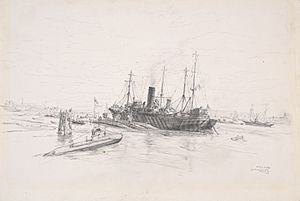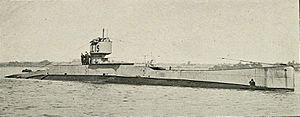HMS Ambrose (1903) facts for kids

Drawing of HMS Ambrose in dazzle camouflage, at anchor in harbour and surrounded by submarines
|
|
Quick facts for kids History |
|
|---|---|
| Name |
|
| Namesake |
|
| Owner |
|
| Operator |
|
| Port of registry | |
| Route | Liverpool – Brazil |
| Builder | Sir Raylton Dixon, Middlesbrough |
| Cost | £89,000 |
| Yard number | 496 |
| Launched | 31 March 1903 |
| Completed | September 1903 |
| Acquired | by Admiralty, 20 October 1915 |
| Maiden voyage | 20 September 1903 |
| Identification | |
| Fate | Scrapped 1946 |
| General characteristics | |
| Type |
|
| Tonnage | 1903: 4,187 GRT, 2,128 NRT 1907: 4,588 GRT, 2,490 NRT |
| Displacement | 6,600 tons |
| Length |
|
| Beam | 47.8 ft (14.6 m) |
| Draught | 20 ft 9 in (6.3 m) |
| Depth | 26.4 ft (8.0 m) |
| Installed power | |
| Propulsion |
|
| Speed | 14.5 knots (27 km/h) |
| Capacity | 1903: 149 first class, 330 steerage |
| Crew |
|
| Armament |
|
HMS Ambrose was a special kind of ship that started out as a passenger liner in 1903. She carried people and goods for the Booth Steam Ship Company, sailing between Liverpool, England, and Brazil.
When World War I began, Ambrose was changed into an armed merchant cruiser for the Royal Navy. Later, in 1917, she became a submarine depot ship, which means she supported submarines.
After the First World War, Ambrose helped Royal Navy submarines in the Far East from 1919 to 1928. Then, she was put into the Reserve Fleet, waiting for future use.
In 1938, Ambrose got a new name: HMS Cochrane. She was then converted into a destroyer depot ship, supporting destroyers. Cochrane survived World War II and was finally taken apart for scrap metal in 1946.
Contents
Building a Ship: HMS Ambrose's Start
Sir Raylton Dixon and Company built Ambrose in Middlesbrough, England. She cost about £89,000 to build. The ship was launched into the water on March 31, 1903, and was finished by September of that year.
Ambrose was 387 ft 5 in (118.1 m) long overall. Her width, called her beam, was 47.8 ft (14.6 m). She had one screw (propeller) to push her through the water. Her engine was a powerful triple-expansion steam engine, which gave her a speed of about 14.5 knots (27 km/h) (knots).
The ship was officially registered in Liverpool, England. Her unique identification number was 118405.
Life as a Passenger Liner
The Booth Line used Ambrose to carry both cargo and passengers. She sailed on regular trips between Europe and Brazil. In the early 1900s, this included journeys from Liverpool all the way to Manaus, a city about 1,000 miles (1,600 km) up the Amazon River.
Ambrose made her first trip from Liverpool to Manaus in September or October 1903.
In 1906, Ambrose had a small accident in Brazil. She ran aground (got stuck) in the Amazon River and was damaged. After a week, she was freed and returned to Liverpool for repairs.
While being repaired, the Booth Line decided to make Ambrose bigger. They added more space for passengers, increasing her capacity. This work was finished in March 1907 and cost £17,000. By 1914, Ambrose also had wireless telegraphy equipment, which allowed her to send and receive messages over long distances.
Becoming an Armed Merchant Cruiser
On November 20, 1914, the British Admiralty (the Royal Navy's leaders) took over Ambrose. They changed her into an armed merchant cruiser (AMC). This meant she was given eight 4.7-inch guns and two 6-pounder guns.
She officially joined the Royal Navy on December 10, 1914, as HMS Ambrose. She was part of the 10th Cruiser Squadron, helping the Allied forces blockade Germany. Her job was to patrol the seas between the British Isles, Iceland, and Norway.
In March 1915, a submarine attacked Ambrose three times off the coast of Scotland. Each time, Ambrose fired back. After the third attack, the submarine stopped, and the crew of Ambrose thought they might have sunk it. Later, in May, submarines attacked her again near Skerryvore.
Ambrose's time as an armed merchant cruiser ended in September 1915. The Admiralty then bought her from the Booth Line on October 20, 1915.
Supporting Submarines: A New Role
In 1917, HMS Ambrose was changed again, this time into a submarine depot ship. This type of ship acts like a floating base for submarines, providing supplies, repairs, and a place for their crews to rest. She had a crew of 238 officers and sailors.
After World War I, in October 1919, Ambrose was sent to Hong Kong to support the Fourth Submarine Flotilla. Six L-class submarines traveled with her. They arrived in Hong Kong in January 1920.
Ambrose spent many years in the Far East, mainly at Royal Navy bases in Hong Kong and Weihaiwei. She also visited other ports like Kobe and Shanghai in 1920, Nagasaki in 1921, and Singapore in 1923.
In 1928, Ambrose and six L-class submarines were called back to Britain. They left Hong Kong in March and arrived back in Britain later that year. In December, Ambrose was taken out of active service and placed in the Maintenance Reserve.
Final Years as HMS Cochrane
On June 1, 1938, Ambrose was given her final name: HMS Cochrane. She was converted into a destroyer depot ship, meaning she would now support destroyers instead of submarines. Some sources also describe her role in World War II as a "base ship."
During World War II, in 1940, her Bomb Disposal Officer played an important role. He was responsible for safely removing a German shell that hit HMS Prince of Wales but did not explode during a battle with the German battleship Bismarck.
HMS Cochrane survived the war. In 1946, she was officially taken out of service. That November, she was sent to Inverkeithing to be broken up for scrap metal by ship breakers Thos. W. Ward.


